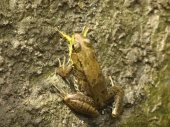You can tell the gender of adult Bullfrogs any time of the year by looking at the tympanic membrane (the circular structure behind the eye). Males have a large tympanic membrane that is about twice the diameter of the eye, a female's tympanic membrane is about the same diameter as the eye. During the breeding season the males will develop yellow coloring on the ventral surface of their head and their thumbs will become enlarged. Females don't develop the yellow coloring and their thumbs remain about the same size as the other three digits. Adult males are the ones that make the characteristic bellowing sound which comes from the tympanic membrane. The tympanic membrane also covers the hearing organs.
In the fall of 1994 the laboratory director at a major medical school saw a small ad that we had placed in the classified section of Reptile and Amphibian
Magazine. She called and asked if we could supply her with 20 Bullfrogs to be used for training doctors in microsurgery techniques on blood vessels. We sent them to her; up to that point we had only sold a few pairs to enthusiasts.
A couple weeks later she called us back very excited. Most of the Bullfrogs had survived the surgery and had healed up. Something that had never happened before. She had a colleague who wanted some of our Bullfrogs for heart muscle studies. A
light bulb came on in our minds. We had some flyers with some basic info on our farm-raised Bullfrogs printed up they featured a photo of my wife in her lab coat holding large Bullfrogs on her open upturned hands. We mailed them out to some medical schools and got a small response. In the meantime the first two researchers contacted more of their colleagues about our Bullfrogs and we got more orders.
It turned out that laboratory frog suppliers (our competition) were providing wild-caught frogs that were skinny and hyper-active, with worn off snouts, sores, broken bones and digits, and generally stressed out. Our fat, happy, and docile farm-raised Bullfrogs were the exact opposite and they were less expensive. Word spread in the research community, the rest is history.
Our original medical school still orders about 250 live Bullfrogs each year.
Our Bullfrogs average about $61.00/lb., overhead is pretty low now that most of our infrastructure is in place. We have a business License, a Commercial Rearing License, an Invasive Species Possession Permit, and a Live Fish Transport Permit.

 8
8








 1
1




 2
2




 1
1




 2
2
















 2
2








 1
1








 1
1




 3
3




 1
1




 3
3



















